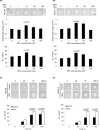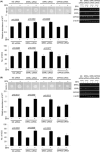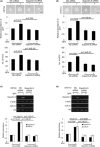Environmental-relevant bisphenol A exposure promotes ovarian cancer stemness by regulating microRNA biogenesis
- PMID: 37610061
- PMCID: PMC10494296
- DOI: 10.1111/jcmm.17920
Environmental-relevant bisphenol A exposure promotes ovarian cancer stemness by regulating microRNA biogenesis
Abstract
Bisphenol A (BPA) is a ubiquitous environmental xenobiotic impacting millions of people worldwide. BPA has long been proposed to promote ovarian carcinogenesis, but the detrimental mechanistic target remains unclear. Cancer stem cells (CSCs) are considered as the trigger of tumour initiation and progression. Here, we show for the first time that nanomolar (environmentally relevant) concentration of BPA can markedly increase the formation and expansion of ovarian CSCs concomitant. This effect is observed in both oestrogen receptor (ER)-positive and ER-defective ovarian cancer cells, suggesting that is independent of the classical ERs. Rather, the signal is mediated through alternative ER G-protein-coupled receptor 30 (GPR30), but not oestrogen-related receptor α and γ. Moreover, we report a novel role of BPA in the regulation of Exportin-5 that led to dysregulation of microRNA biogenesis through miR-21. The use of GPR30 siRNA or antagonist to inhibit GPR30 expression or activity, respectively, resulted in significant inhibition of ovarian CSCs. Similarly, the CSCs phenotype can be reversed by expression of Exportin-5 siRNA. These results identify for the first time non-classical ER and microRNA dysregulation as novel mediators of low, physiological levels of BPA function in CSCs that may underlie its significant tumour-promoting properties in ovarian cancer.
Keywords: bisphenol A; cancer stem cells; microRNA; oestrogen receptors; ovarian cancer.
© 2023 The Authors. Journal of Cellular and Molecular Medicine published by Foundation for Cellular and Molecular Medicine and John Wiley & Sons Ltd.
Figures







Similar articles
-
Bisphenol A at a low concentration boosts mouse spermatogonial cell proliferation by inducing the G protein-coupled receptor 30 expression.Toxicol Appl Pharmacol. 2013 Feb 15;267(1):88-94. doi: 10.1016/j.taap.2012.12.014. Epub 2012 Dec 26. Toxicol Appl Pharmacol. 2013. PMID: 23274518
-
Long-Term Exposure of Early-Transformed Human Mammary Cells to Low Doses of Benzo[a]pyrene and/or Bisphenol A Enhances Their Cancerous Phenotype via an AhR/GPR30 Interplay.Front Oncol. 2020 May 29;10:712. doi: 10.3389/fonc.2020.00712. eCollection 2020. Front Oncol. 2020. PMID: 32670863 Free PMC article.
-
Bisphenol A and its derivatives tetrabromobisphenol A and tetrachlorobisphenol A induce apelin expression and secretion in ovarian cancer cells through a peroxisome proliferator-activated receptor gamma-dependent mechanism.Toxicol Lett. 2017 Mar 5;269:15-22. doi: 10.1016/j.toxlet.2017.01.006. Epub 2017 Jan 19. Toxicol Lett. 2017. PMID: 28111160
-
Role of cancer stem cells and microRNA in resistance to chemotherapy in patients with ovarian cancer.Eur J Gynaecol Oncol. 2017;38(2):181-183. Eur J Gynaecol Oncol. 2017. PMID: 29953775 Review.
-
A systematic review of microRNA expression studies with exposure to bisphenol A.J Appl Toxicol. 2021 Jan;41(1):4-19. doi: 10.1002/jat.4025. Epub 2020 Jul 14. J Appl Toxicol. 2021. PMID: 32662106
References
-
- Tschersich C, Murawski A, Schwedler G, et al. Bisphenol A and six other environmental phenols in urine of children and adolescents in Germany–human biomonitoring results of the German environmental survey 2014–2017 (GerES V). Sci Total Environ. 2021;763:144615. doi:10.1016/j.scitotenv.2020.144615 - DOI - PubMed
Publication types
MeSH terms
Substances
LinkOut - more resources
Full Text Sources
Medical

